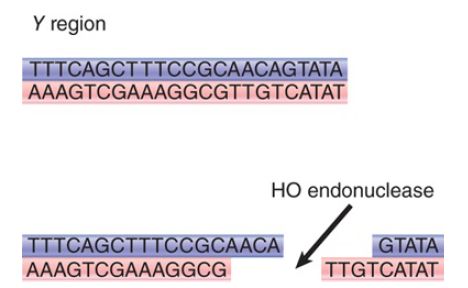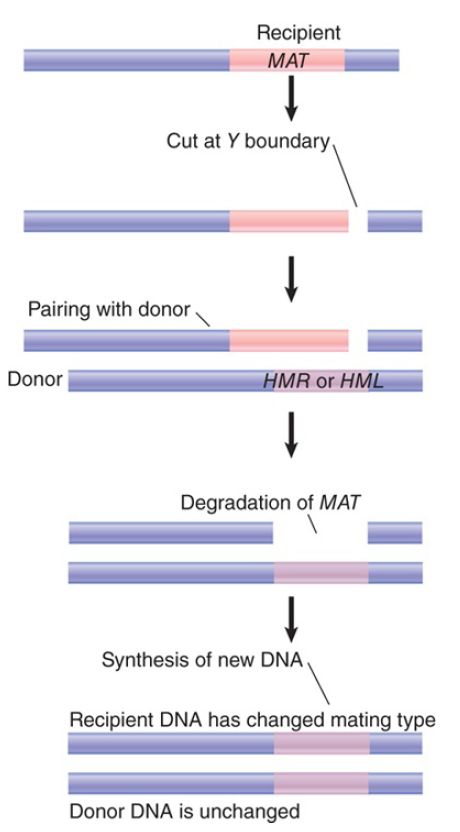


 النبات
النبات
 الحيوان
الحيوان
 الأحياء المجهرية
الأحياء المجهرية
 علم الأمراض
علم الأمراض
 التقانة الإحيائية
التقانة الإحيائية
 التقنية الحيوية المكروبية
التقنية الحيوية المكروبية
 التقنية الحياتية النانوية
التقنية الحياتية النانوية
 علم الأجنة
علم الأجنة
 الأحياء الجزيئي
الأحياء الجزيئي
 علم وظائف الأعضاء
علم وظائف الأعضاء
 الغدد
الغدد
 المضادات الحيوية
المضادات الحيوية| Unidirectional Gene Conversion Is Initiated by the Recipient MAT Locus |
|
|
|
Read More
Date: 24-3-2021
Date: 11-5-2016
Date: 19-12-2015
|
Unidirectional Gene Conversion Is Initiated by the Recipient MAT Locus
KEY CONCEPTS
- Mating-type switching is initiated by a double-strand break made at the MAT locus by the HO endonuclease.
- The recombination event is a synthesis-dependent strand-annealing reaction.
A switch in mating type is accomplished by a gene conversion in which the recipient site (MAT) acquires the sequence of the donor type (HML or HMR). Sites needed for the recombination have been identified by mutations at MAT that prevent switching. The unidirectional nature of the process is indicated by lack of mutations in HML or HMR.
The mutations identify a site at the right boundary of Y at MAT that is crucial for the switching event. The nature of the boundary is shown by analyzing the locations of these point mutations relative to the site of switching (this is done by examining the results of rare switches that occur in spite of the mutation). Some mutations lie within the region that is replaced (and thus disappear from MAT after a switch), whereas others lie just outside the replaced region (and therefore continue to impede switching). Thus, sequences both within and outside the replaced region are needed for the switching event.
Switching is initiated by a DSB close to the Y–Z boundary that coincides with a site that is sensitive to attack by DNase. (This is a common feature of chromosomal sites that are involved in initiating transcription or recombination.) It is recognized by the endonuclease encoded by the HO locus. The HO endonuclease makes a staggered DSB just to the right of the Y boundary.
Cleavage generates the single-stranded ends of four bases illustrated in FIGURE 1. The nuclease does not attack mutant MAT loci that cannot switch. Deletion analysis shows that most or all of the sequence of 24 bp surrounding the Y junction is required for cleavage in vitro. The recognition site is relatively large for an endonuclease, and it occurs only at the three mating-type cassettes.

FIGURE 1. HO endonuclease cleaves MAT just to the right of the Y region, which generates sticky ends with a 4-base overhang.
Only the MAT locus, and not the HML or HMR locus, is a target for the endonuclease. It seems plausible that the same mechanisms that keep the silent cassettes from being transcribed also keep them inaccessible to the HO endonuclease. This inaccessibility ensures that switching is unidirectional.
The reaction triggered by the cleavage is illustrated schematically in FIGURE 2 in terms of the general reaction between donor and recipient regions. The recombination occurs through an SDSA mechanism, as described earlier. As expected, the stages following the initial cut require the enzymes involved in general recombination. Mutations in some of these genes prevent switching. In fact, studies of switching at the MAT locus were important in the development of the SDSA model.

FIGURE 2. Cassette substitution is initiated by a double-strand break in the recipient (MAT) locus and may involve pairing on either side of the Y region with the donor (HMR or HML) locus.



|
|
|
|
إجراء أول اختبار لدواء "ثوري" يتصدى لعدة أنواع من السرطان
|
|
|
|
|
|
|
دراسة تكشف "سببا غريبا" يعيق نمو الطيور
|
|
|
|
|
|
جامعة الكفيل تناقش تحضيراتها الخاصة بالامتحانات النهائية
|
|
|
|
المجمع العلمي يستأنف برنامج (عرش التلاوة) الوطني
|
|
|
|
أرباح مصرف الراجحي ترتفع إلى 4.4 مليار ريال في الربع الأول
|
|
|
|
الأمانة العامة للعتبة العبّاسية تشارك في مُلتقى أمناء العتبات المقدّسة داخل العراق
|